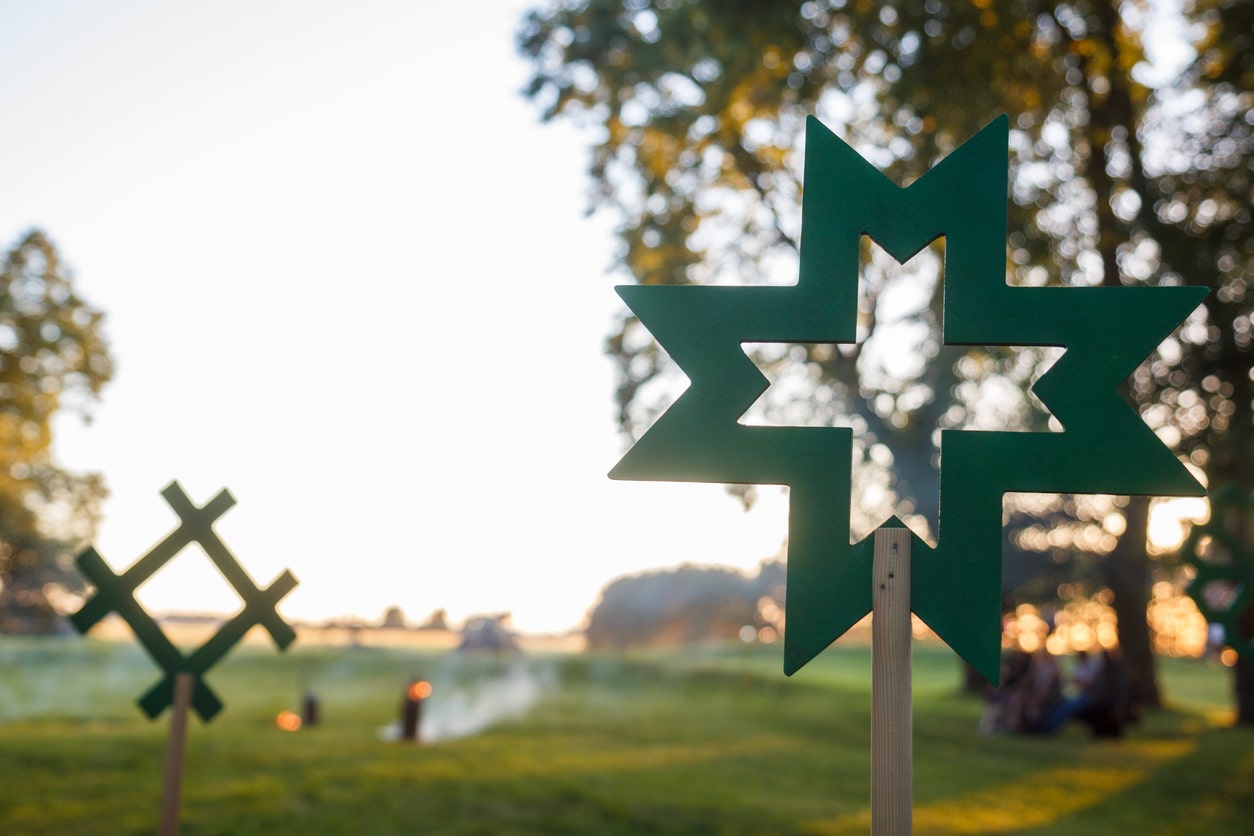What shapes Latvian national identity? The answer is complex and personal, but one key element is the Latvian national narrative. This includes the heroes and pivotal events taught in schools, the places central to the nation’s collective memory, and the language and beliefs that frame its worldview.
A national narrative goes beyond history: it is the people, events, places, and values that define how a nation understands itself. It lives in literature, film, and art, in monuments and place names, and in the calls to action used by leaders and activists.
This resource presents Latvia’s national narrative in a concise, accessible way to help outsiders—tourists, students, and diplomats—grasp the cultural foundations of Latvian society and better understand the Latvian nation.
Special Themes in Latvian Identity
Latvia’s population is about 60% Latvian. The most common religion is Lutheranism at 38%. In second place are those that identify with no religion – at about 30%.
Pagan rites are deeply embedded into Latvian culture and identity. Key seasonal turning points, especially the winter and summer solstices, are Latvia’s main holidays. They are widely marked with ancient celebrations that revolve around the power of water, fire, vegetation, and light. While generally not seen as connected to pagan gods, Latvians do see these celebrations as connecting them to both nature and their Latvian identity, meaning that they still serve a spiritual function.
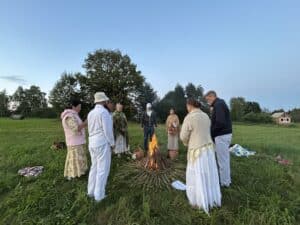
Connection to nature runs deep in Latvian identity. Many holidays are celebrated outdoors and foods gathered from forests are part of traditional Latvian cuisine.
Language, Homeland, and Culture play unique roles in Latvian identity. Language is usually a strong identity marker. However, while Latvians value their language, they also recognize that, historically, not all those who call Latvia home speak Latvian. Many have spoken German, Russian, or Yiddish. Descendents of the large Latvian diaspora are even less likely to speak Latvian. For Lativans, ancestral ties to the Latvian homeland and an interest in integrating with and supporting Latvian culture are far more important to being considered Latvian.
Organized Religion also plays very little role in Latvian identity. Historically the population has been officially Lutheran, Catholic, or Orthodox, although only about 7% of the population attends religious services regularly today. About a third do not identify with any religion. Latvia is one of the least religious societies in the world.
A history of imperial domination has left Latvia highly conscious of its status as a small nation surrounded by larger nations and its consequent need to maintain strong alliances with states that can collectively help Latvia defend itself from potential invasion.
Dainas are traditional Latvian folk songs. They are most often short, written in four-line stanzas with simple rhymes and rhythms, making them easy and fun to learn and sing. They center on nature, daily life, love, family, Latvian mythology, and simply being Latvian. They were integral to preserving national identity and collective memory under foreign occupation. “The Singing Revolution,” which gained Latvia its independence from the USSR, relied heavily on dainas sung at protests. Every five years, a massive Latvian Song and Dance Festival honors the tradition of the daina.
Art Nouveau architecture flourished during the Latvian National Awakening at the turn of the 20th century. Incorporating elements of local history, mythology, flora, and fauna, the Latvians took a European trend and turned it into an expression of national identity. Furthermore, most of the buildings survived the two world wars that followed their construction. This means that Latvia now has the greatest concentration of art nouveau buildings anywhere. They are a point of national pride and a defining element of many Latvian cities.
Geography in Latvian Culture
Latvian regions each have a unique identity formed from the influences of empires that once ruled them as well as from Latvia’s indigenous Baltic tribes. Influences can be felt in dialect, cuisine, and other identity markers. Many Latvians see their identities as having national and regional components. Major historical regions include those listed below.
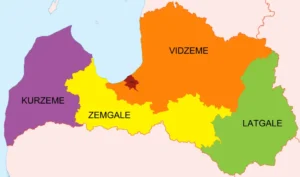
Vidzeme was ruled by the Swedish Empire in the 17th century before being absorbed into the Russian Empire. The Swedes introduced liberal policies that empowered the local peasants and encouraged education, creating a class of Latvians that would go on to help lead the country’s unification and eventually the Latvian National Awakening. The region’s major indigenous tribe was the Latgalians, who came to have a formative role in Latvian identity. They were known as craftsmen, traders, and diplomats.
Kurzeme (Courland) is named for the Curonians, an indigenous warrior tribe skilled at sailing. As a semi-independent duchy under the Polish-Lithuanian Commonwealth in the 16th and 17th centuries, they put their skills to use, carrying out trade and even establishing short-lived colonies in Africa and the Caribbean. Kurzeme cuisine is particularly known for fish, including herring and eel dishes.
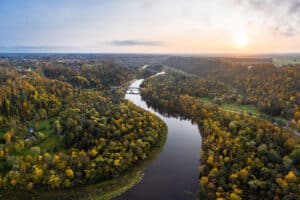
Latgale, named for the same Latgalians that populated Vidzeme, was annexed by the Russian empire in the first partition of Poland and remained a Russian stronghold for most of its history thereafter. Its major city, Daugavpils, is Latvia’s second largest and has the highest concentration of Russians in a major Latvian city, at nearly half.
Zemgale (Semigallia), is named for the Semigallians, who were known as fierce warriors and skilled agriculturalists who controlled Latvia’s best agricultural land. They were the last to be conquered by the Crusaders and helped lead the resistance against them. Zemgale cuisine is known for being heavy on bread, eggs, dairy, and vegetables and is particularly well known for its cheese.
Riga is Latvia’s capital city and, within its metropolitan area, is home to about half of Latvia’s population and produces close to half its GDP. While other cities, towns, and villages in Latvia contain commendable cultural institutions, Riga stands out in the Latvian national consciousness as the economic, cultural, and political capital of the nation.
Latvian Historical Heroes
The following people have played pivotal roles in Latvia’s history and can be thought of as “founding fathers.” You may see monuments to them and places named for them.
Viesturs was a 13th century leader of the Semigallians, one of several Baltic tribes that eventually merged to become Latvian. He helped lead the resistance against the Livonian Brothers of the Sword, the first major power to conquer Latvia. His legacy is commemorated today through the Order of Viesturs, one of Latvia’s highest state honors. It is given to those who have contributed to Latvia’s defense, civic consciousness, and border protection.
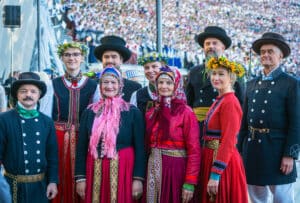
Andrejs Pumpurs was a 19th-century poet and military officer who created Lāčplēsis, Latvia’s national epic. An enthusiast of Latvian narrative song and folklore from a young age, Pumpurs incorporated these forms into his work, which spans about 5000 lines of poetry. Usually translated as “The Bear Slayer,” it follows a Latvian warrior through incredible acts of bravery and strength. It was an early and ambitious use of Latvian as a literary language and is regarded as one of its finest examples. Today, there are streets, squares, and statues dedicated to him, and a museum specially dedicated to him and Lāčplēsis.
Krišjānis Barons was a writer and linguist who, at the turn of the 20th century, collected and systematized some 200,000 Latvian dainas (folk songs) from across Latvia. He published them as the multivolume Latvju Dainas (Latvian Folk Songs). This not only helped to preserve what had been a largely oral tradition, it brought together an important part of Latvia’s several regional cultures, helping to solidify them into a single Latvian national identity. His name and image are frequently associated with Latvian cultural events and institutions. To honor his work, the original text is kept in Latvia’s National Library, the house where he wrote the text is now a museum, and there are several statues to him throughout the country. The songs are now part of Latvia’s Song and Dance Festival, a major national event held every five years and itself considered an expression of Latvia’s national identity.
Krišjānis Valdemārs was a writer, educator, politician, and economist, who helped found and lead The First Latvian National Awakening in the late 1800s. He encouraged Latvians to view their identity as equal to any other. To help make this possible, he helped found the first Latvian-language library, contributed to Latvian-language newspapers, and played a central role in the establishment of a system of naval trade schools focused on Latvians. These schools helped integrate former peasants into the lucrative maritime industry that had been made largely inaccessible to them before. His vision was that Latvians could break free from a legacy of serfdom and become successful sailors, traders, shipbuilders, and entrepreneurs. Through education, he helped to create an economically independent and self-reliant Latvian population. Today, there are many monuments and memorials dedicated to him and many educational institutions named for him.
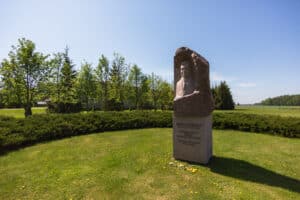
Kārlis Ulmanis was the first prime minister of the Latvian Republic and helped lead it through much of its existence from 1918-1940. He managed the country through the Latvian War of Independence (1918-1920) and laid the groundwork for the modern state, pushing through agricultural reforms, economic modernization, and attracting foreign investment. Although largely successful, he became increasingly frustrated with political infighting, especially as threats mounted from the USSR and Nazi Germany. In 1934 he dissolved parliament, outlawed all political parties (including his own) and established a dictatorship with the help of the military. His coup was bloodless and he repressed dissent mostly through deportations and censorship rather than outright violence. His government focused on promoting economic self-sufficiency and national pride, focusing on the economy, education, and culture. Ulmanis’ rule came to an abrupt end in 1940 when the Soviet Union occupied Latvia. Ulmanis chose not to resist the Soviet forces, believing that resistance would lead to greater bloodshed. Soon after, he was arrested by the Soviets, deported to the Russian interior, and died in captivity in 1942. Although he ended his rule as a dictator, many Latvians remember him as leading the nation through a golden age of prosperity and national freedom. Some criticize him for his repressions and/or for not doing more to resist the Soviets. Statues and memorials dedicated to Kārlis Ulmanis can be found throughout Latvia. His former residence in Pikšas, Latvia, has been turned into a museum dedicated to his life and legacy.
Rainis and Aspazija were the pen names of Jānis Pliekšāns and Elza Pliekšāne, respectively. They were married. Both poets, playwrights, and key figures in Latvian social, political, and intellectual life at the turn of the 20th century, both championed social democracy, equal rights for women, and independence and sovereignty for Latvians both as a nation and as an ethnic identity. Rainis additionally served in parliament, working to codify these ideals. Rainis’ masterpiece Fire and Night (Uguns un nakts), written in 1905, is a landmark of Latvian theater, featuring the legendary Latvian hero Lāčplēsis, who battles for his nation’s freedom. Aspazija is perhaps best known for The Silver Veil (Sidraba šķidrauts), also written in 1905, which advocates for women’s liberation and national consciousness. There are now two museums dedicated to the couple as well numerous monuments dotted around the country that celebrate them as a couple or individually.
Many non-ethnic Latvians also number as Latvian national heroes. For, instance, George Armitstead was an Englishman appointed by the Russian Tsar to be the mayor of Riga at the turn of the 20th century. He led the city through the Latvian National Awakening, a major industrial renaissance, and oversaw the boom in the art nouveau architecture that is now a point of national pride in Riga. Sergei Eisenstien, a Russian-speaking Jew who was born in Latvia, went on to be a globally-famous filmmaker with most of his education and work performed outside of Latvia. Mark Rothko was a German-speaking Jew who left Latvia in his youth and later became a well-known abstract painter in the US. Mikahail Barishnikov was a Russian born in Latvia who became a famous ballet dancer, dissident, and exile. All of these people are often considered national heroes in Latvia because they have a connection to the soil and/or worked for the betterment of Latvia, which, to many Latvians, is most important to making one part of Latvian identity.
Historical Events
These historical events were pivotal in the formation of the Latvian national narrative. They are parts of Latvia’s story that are taught to school children and considered fundamental components of the shared memory of Latvians. For a full history of Latvia, see the article at our sister site, Geohistory.
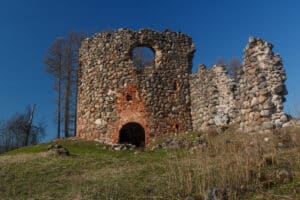
The Livonian Crusade (1198-1290) was declared by the Pope and carried out largely by Germanic knights. The result was that the Baltic tribes, the last pagan, independent forces in Europe, were forcibly Christianized, integrated into Europe, and left with a Germanic ruling class for centuries. This occupying force would build Latvia’s major cities as well as numerous castles and fortified estates (largely to protect themselves from the Latvians they ruled). Many of the castles still exist (largely as museums). The Crusade was also the first time that the independent tribes had to unite against a major foreign force. They found ways to resist politically, militarily, and culturally – preserving their deeply held pagan beliefs and traditions. Eventually, their languages and identities largely converged, becoming what we now know as the modern Latvian nation.
The Swedish Era (1629 to 1721) was the period when Sweden ruled what is now the northern Latvian province of Vidzeme and the capital city of Riga. The Swedes brought relatively progressive reforms, reducing the power of the German nobility and providing legal protections for the peasants. Sweden built infrastructure and opened public schools. These reforms laid the groundwork for an educated Latvian population, which later played a key role in the 19th-century Latvian National Awakening. Long after Sweden lost control of its Baltic territories, Vidzme and Riga remained known for higher education levels and better infrastructure than other areas that remained under German, Polish, or Russian control. To this day, the Swedish era is remembered fondly in Latvian history and Latvia maintains good relations with Sweden.
The Latvian National Awakening, which began in the 1850s, was by far the most important event in the creation of Latvia’s national narrative. Latvians had, since the crusades, been peasants or serfs with limited rights, toiling under an entrenched German nobility, and ruled by an imperial force: Polish, German, Russian, or Swedish. The National Awakening was the first time since the Livonian Crusade that Latvians began to demand equality en masse. The Awakening saw Latvians promote their language, folklore, and cultural heritage. Trade schools were founded by Latvians to assist other Latvians in becoming financially independent. By the turn of the century, Latvians had shifted to political mobilization, with growing demands for Latvian political rights and land reforms. The 1905 Russian Revolution, which spread to Latvia, then part of the Russian Empire, further heightened calls for political reform and autonomy. Eventually, Latvia declared independence in the midst of WWI and pushed both the Germans and the Russians from its land to establish the first independent Latvian Republic.
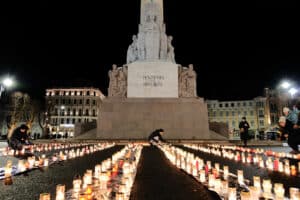
The Soviet Occupation of Latvia began during World War II and lasted until 1991 (with a brief interruption by Nazi German occupation). Latvia, along with Estonia and Lithuania, was forcibly incorporated into the Soviet Union in 1940 following the Molotov-Ribbentrop Pact between Nazi Germany and the Soviet Union. The occupation brought repression, Russification, and cultural suppression. Large numbers of Russian speakers were relocated to Latvia, and by the late 1980s, Latvians were a minority in several urban areas, including Riga. This demographic shift has had a lasting impact, with challenges for Latvia’s national identity and integration efforts for its large Russian-speaking minority after independence. Latvia has also been left with a deep mistrust of Russia and an awareness that it must seek strong alliances to maintain its independence. Thus, Latvia strongly supports NATO and the EU, both of which it quickly joined after regaining independence.
The Singing Revolution was the peaceful protest movement that won Latvia its independence from the USSR. Emboldened by Mikhail Gorbachev’s glasnost policies, Latvians carried out several mass protests in the late 1980s and early 90s. For instance, on June 14, 1989, hundreds of thousands gathered in central Riga to sing traditional Latvian songs in honor of the victims of the 1941 Soviet deportations of Latvians to Siberia. On August 23 of that same year, Lativans, Lithuanians, and Estonians formed a human chain of 2 million people that stretched 370 miles across the three Baltic states. Dubbed “The Baltic Way,” this demonstration captured international attention and showcased the unity and determination of the Baltic peoples to regain their sovereignty. The Singing Revolution also took on a political character with the formation of the Latvian Popular Front, which helped organize protests, won a majority in the Latvian Supreme Soviet in 1990, and eventually issued the proclamation of independence. The fact that the Singing Revolution was achieved through non-violence, and largely by simply expressing Latvian culture and historical memory, remains a point of pride for Latvians.
Diversity in Latvia
Of course, not everyone in Latvia is Latvian. The stories and experiences of a country’s ethnic minorities are also part of the lived experience that defines it as a state.
Russians make up about 25% of Latvia’s total population. They are concentrated in Riga and Daugavpils. Upon Latvia’s independence from the Soviet Union in 1991, citizenship was granted only to descendents of citizens of the pre-Soviet Latvian Republic, which existed from 1918–1940. Most moved to Latvia after the Soviet occupation in 1940, or are descendants of those who arrived then. For these residents of Latvia, naturalization could only be accomplished by proving proficiency in the Latvian language and knowledge of Latvian history and culture. Most could do neither at that time and were given special non-citizen passports which did not convey the right to vote or hold office. The government defends these policies as necessary for social integration and national unity, but this has led many Russian speakers to feel marginalized, as non-citizens do not have the right to vote, yet are still subject to Latvian laws and taxes. They also have more limited ability to push back against state reforms, such as new requirements, in part spurred by geopolitical tensions with Russia, that state-funded Russian-language schools must offer an increasing portion of their instruction in Latvian. While many Latvian Russians hold citizenship and hold an affinity to Latvia, the large Russian minority does create a complex social, demographic, and geopolitical situation inside Latvia. Today, about 10% of Latvia’s population are still non-citizens, the vast majority of whom are Russian speaking.
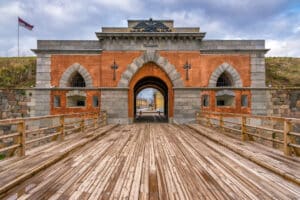
Other Slavic Speaking Minorities account for all minority populations representing more than 2% or more of Latvia’s total population. These are Belarusians (3%) as well as Ukrainians and Poles (2% each).
Jews in Latvia have a long and complex history. At the turn of the century, they numbered around 200,000, probably just under 10% of the population. However, their numbers were decimated first by mass Russian deportations just before WWI and then by the Nazi invasion and Holocaust in WWII. Today, Jews account for around 6,000–8,000 people, or approximately 0.3% of the population. For more, see our Guide to Jewish Latvia.
Livonians are a small, indigenous ethnic group in Latvia, known for their unique Finno-Ugric language and culture. Although they were once the primary indigenous group encountered by the Livonian Crusaders, and were the namesake of that Crusade and the resulting state of Livonia, today there are only around 200 Livonians left and only a few dozen speak Livonian. That said, some younger Livonians have developed an interest in learning the language and preserving cultural traditions, with institutions like The Livonian Cultural Center and the Livonian Institute at the University of Latvia and cultural events and the Livonian Summer Institute. the Livonian Union.
You’ll Also Love
Interview with Patriotic Music Professor in Bishkek
If you want to better understand a country’s government, study its culture. (Если хочешь ближе узнать историю государства, изучай его культурe.) In that spirit, I sat down with one of Kyrgyzstan’s top experts on the most important spheres of Kyrgyz national culture — the art of storytelling. Duishaliev Kamchibek Sharshenovich is a charming music professor […]
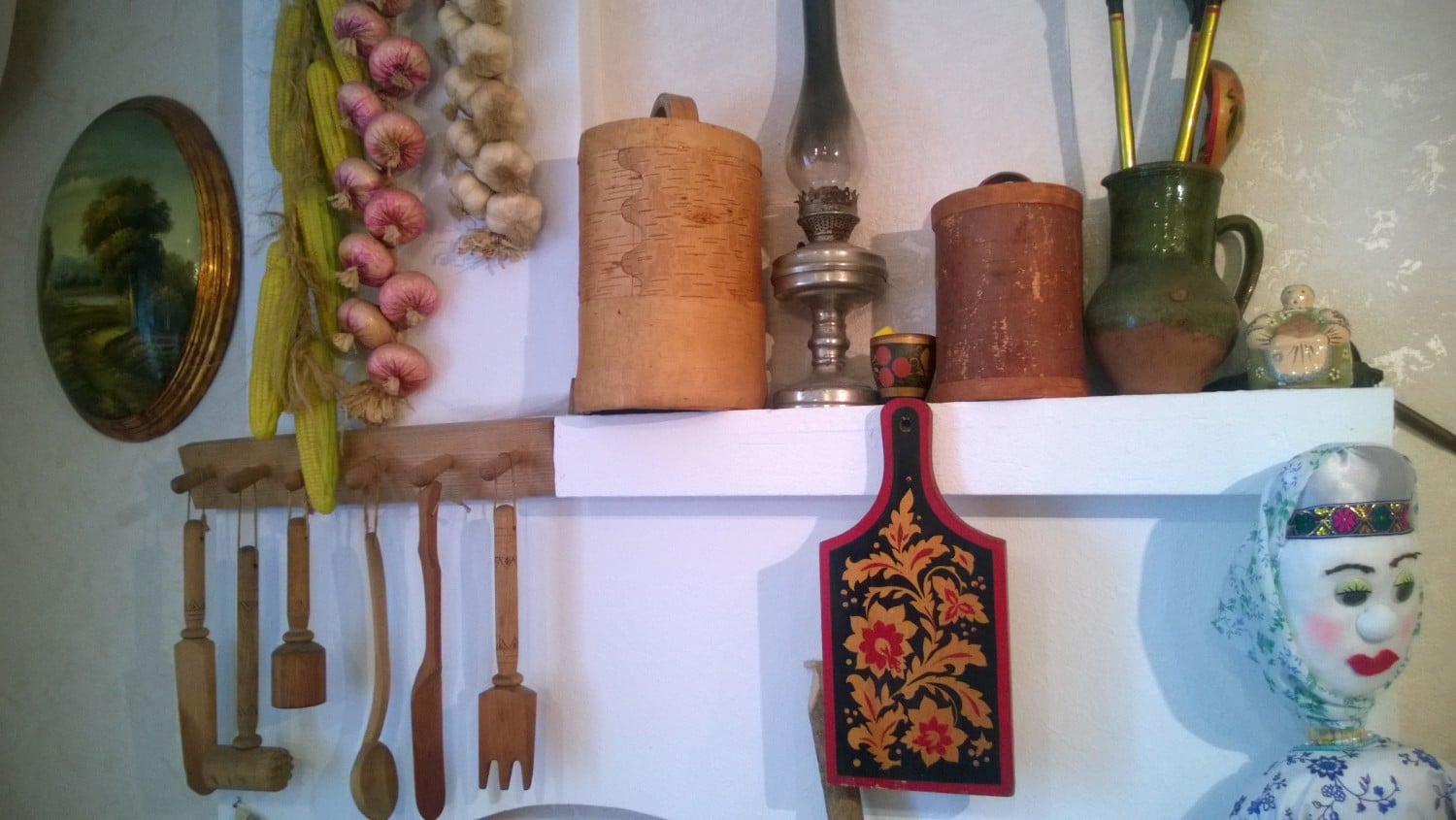
Exploring Russian Traditions in Vladivostok
The international department at VGUES has, throughout the semester, taken us on various excursions around Vladivostok. This week, we ventured back into time to explore some of the old Russian traditions. At a rather nondescript apartment building near the city center, a kind babushka beckoned for our group to come inside. We were then ushered […]

Kyrgyz on Kyrgyzstan
What defines being Kyrgyz? Defining something as broad as a nationality or ethnicity is always complicated. I decided to get a view specifically from young Kyrgyz women and interviewed Bigemai, 27 and Aiza, 22 for their thoughts. Bigemai grew up in Bishkek, the oldest of four siblings. She works professionally as a hairdresser and volunteers […]
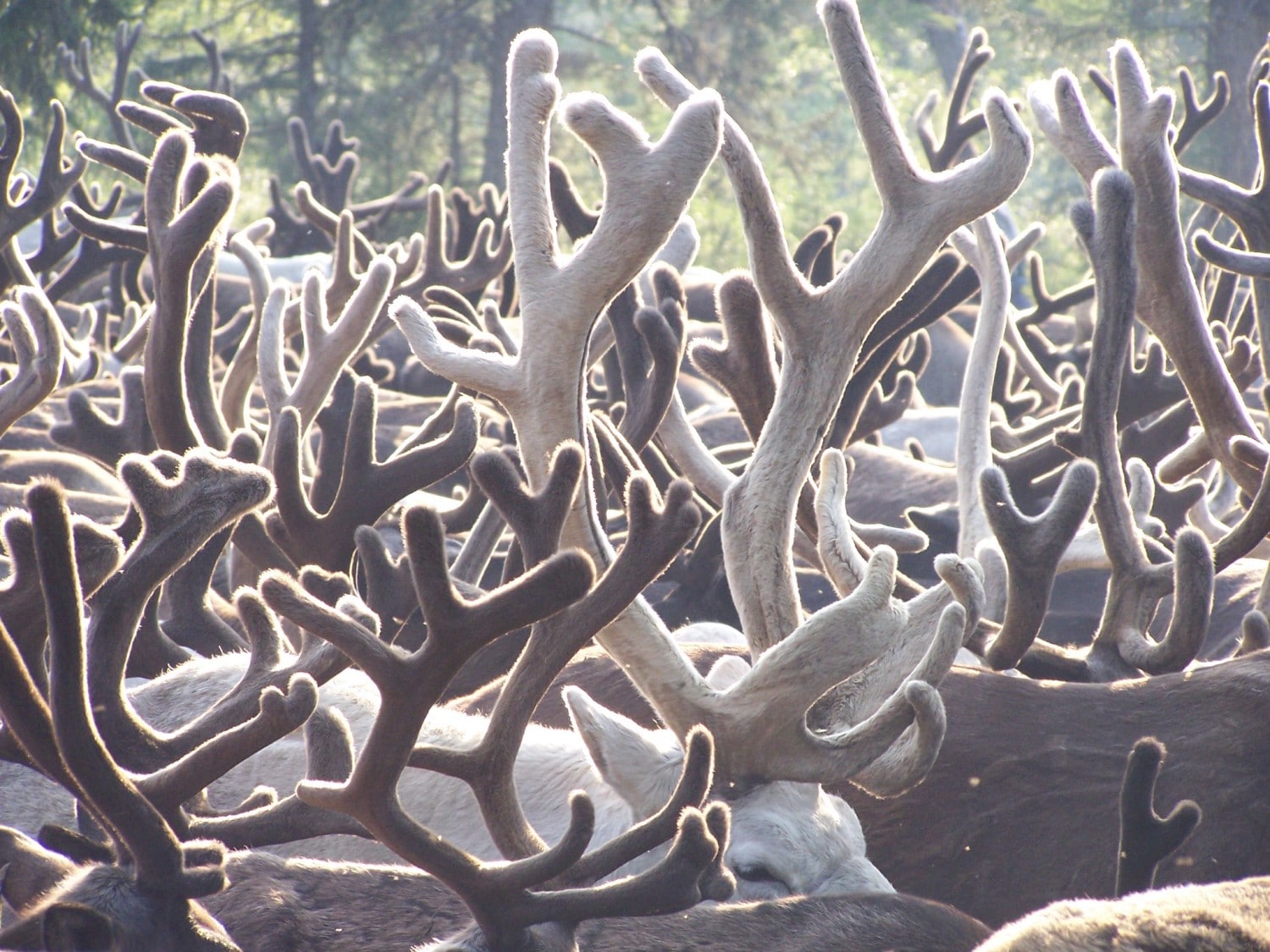
Notes From the Field: Life in a Evenki Reindeer Collective
The Evenki people are an indigenous group of eastern Siberia. They have a distinct language, which is part of the Tungusic language family, and their traditional lifestyle centers around reindeer herding and hunting. They are traditionally nomadic, taking their herds further north in the summer and returning to a more southern settlement in the winter. […]
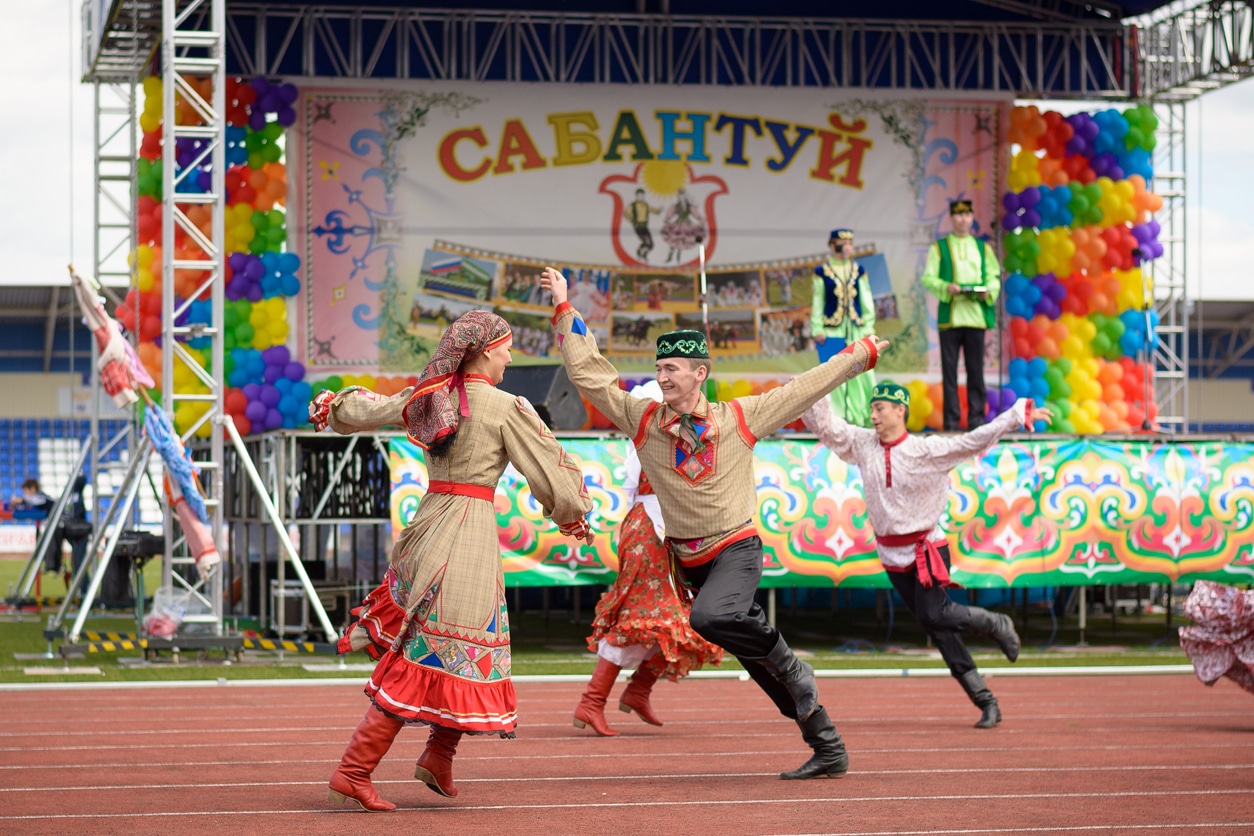
Sabantuy: A Global Summer Festival Celebrating Tatar Heritage
Sabantuy (Сабантуй) is the traditional Volga (Kazan) Tatar summer festival. It dates back to pre-Islamic, pagan times and originally was a ritual that asked the gods for a plentiful harvest. Today, however, the festival can best be understood as a national Tatar celebration of their culture and traditions. Sabantuy are inclusive, community-building events. In Tatarstan, […]

